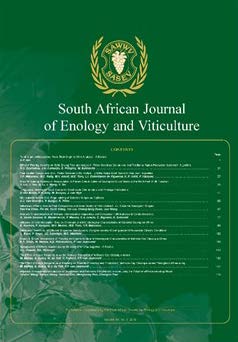Effect of Pruning Severity on Yield, Drying Time and Wages in Flame Seedless Dry-on-vine and Traditional Raisin Production Systems in Argentina
DOI:
https://doi.org/10.21548/39-1-1549Abstract
Raisin grapes are potentially more profitable than wine grapes in San Juan, Argentina, although the traditional system of grape drying requires an extensive use of costly labour. Production costs might be reduced by adopting the dry-on-vine (DOV) raisin-making system, but the feasibility of DOV in Argentina has not been assessed, and neither have the costs and pruning schemes. Thus we determined drying time and yields, estimated wages per hectare, and determined the influence of pruning severity on Flame Seedless raisin grapes. A completely random design with six treatments and six replicates was used in the 2013 to 2016 seasons. The treatments comprised differences in the nodes per cane, nodes per vine,
distribution of nodes, and sugar content. Descriptive statistics and variance analysis were calculated for fresh fruit weight, dry fruit weight, drying ratio and drying time. The leaf area and its relationship with dried fruit weight also were calculated. These data were processed with the Infostat program. The DOV system demands between 11 and 31 additional days during the drying period and reduces labour costs by between 38% and 64% compared to the traditional system. Long pruning with the same load of buds is better. Furthermore, the DOV system is not associated with a lower production and thus appears to be a financially sustainable alternative to traditional production systems for Flame Seedless raisin grape producers in Argentina.
Downloads
References
dry on vine
raisins
Flame Seedless
labor
distribution buds
Downloads
Published
Issue
Section
License
A copyright form will be e-mailed to the corresponding author when the manuscript has been accepted for publication.
In principle, the Author agrees to the following when he/she signes the copyright agreement:
I hereby assign to the SOUTH AFRICAN SOCIETY FOR ENOLOGY AND VITICULTURE (SASEV) the copyright of the text, tables, figures, supplementary material, illustrations and other information (the Material) submitted with the manuscript to be published in SOUTH AFRICAN JOURNAL OF ENOLOGY AND VITICULTURE (SAJEV) (the "Article"). The copyright becomes effective from the date the Article has been accepted for publication in SAJEV.
This is an open access journal, and the authors and journal should be properly acknowledged, when works are cited.
Author's may use the publishers version for teaching purposes, in books, theses, dissertations, conferences and conference papers.
A copy of the authors' publishers version may also be hosted on the following websites:
- Non-commercial personal webpage or blog.
- Institutional webpage.
- Authors Institutional Repository.
The following notice should accompany such a posting on the website: This is an electronic version of an article published in SAJEV, Volume XXX, number XXX, pages XXX - XXX, DOI. Authors should also supply a hyperlink to the original paper or indicate where the original paper (www.journals.ac.za/index.php/sajev/) may be found.
Authors publishers version, affiliated with the Stellenbosch University will be automatically deposited in the University's Institutional Repository SUNScholar.
Articles as a whole, may not be re-published with another journal.
The following license applies:
Attribution CC BY-NC-ND 4.0

